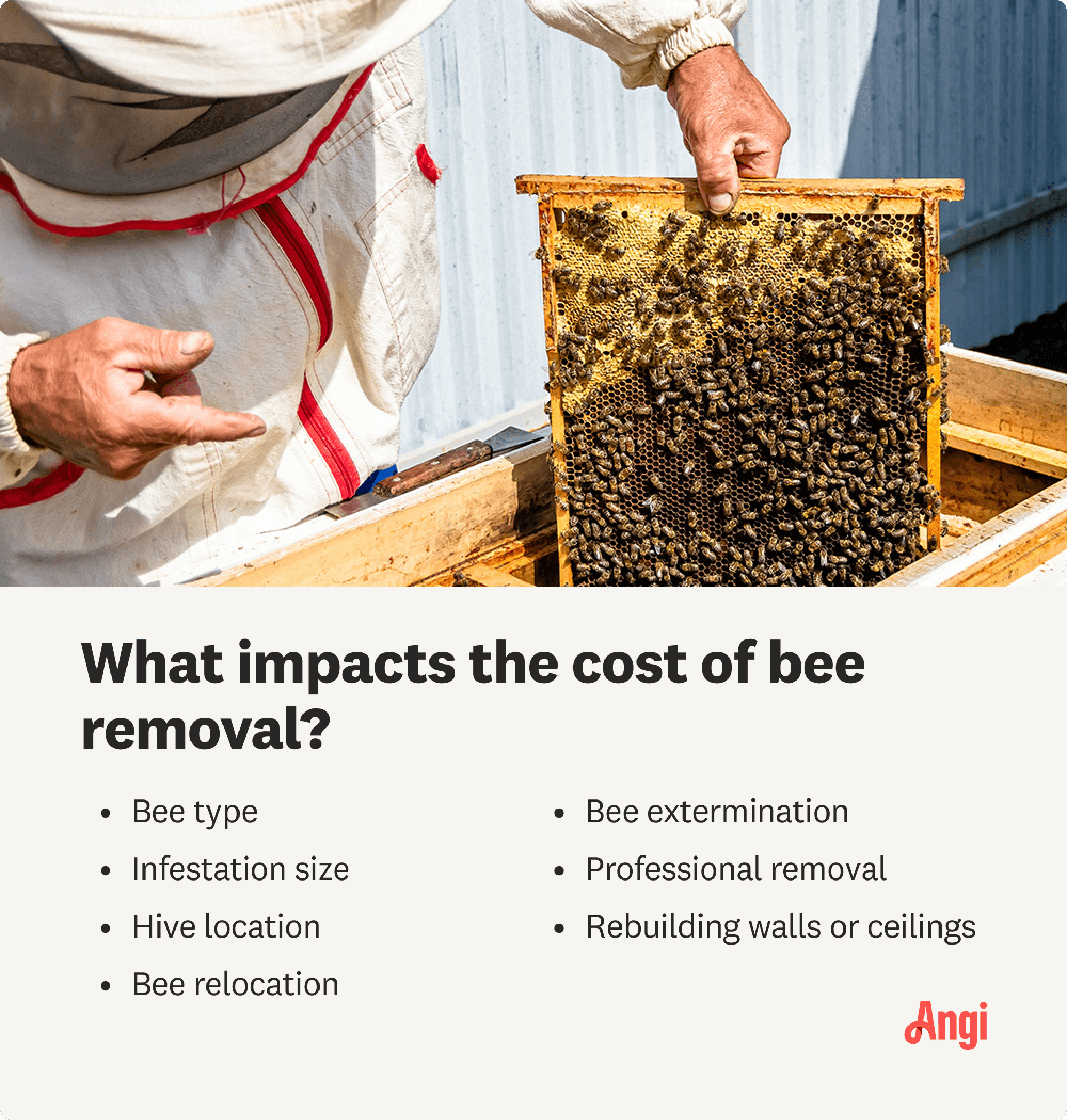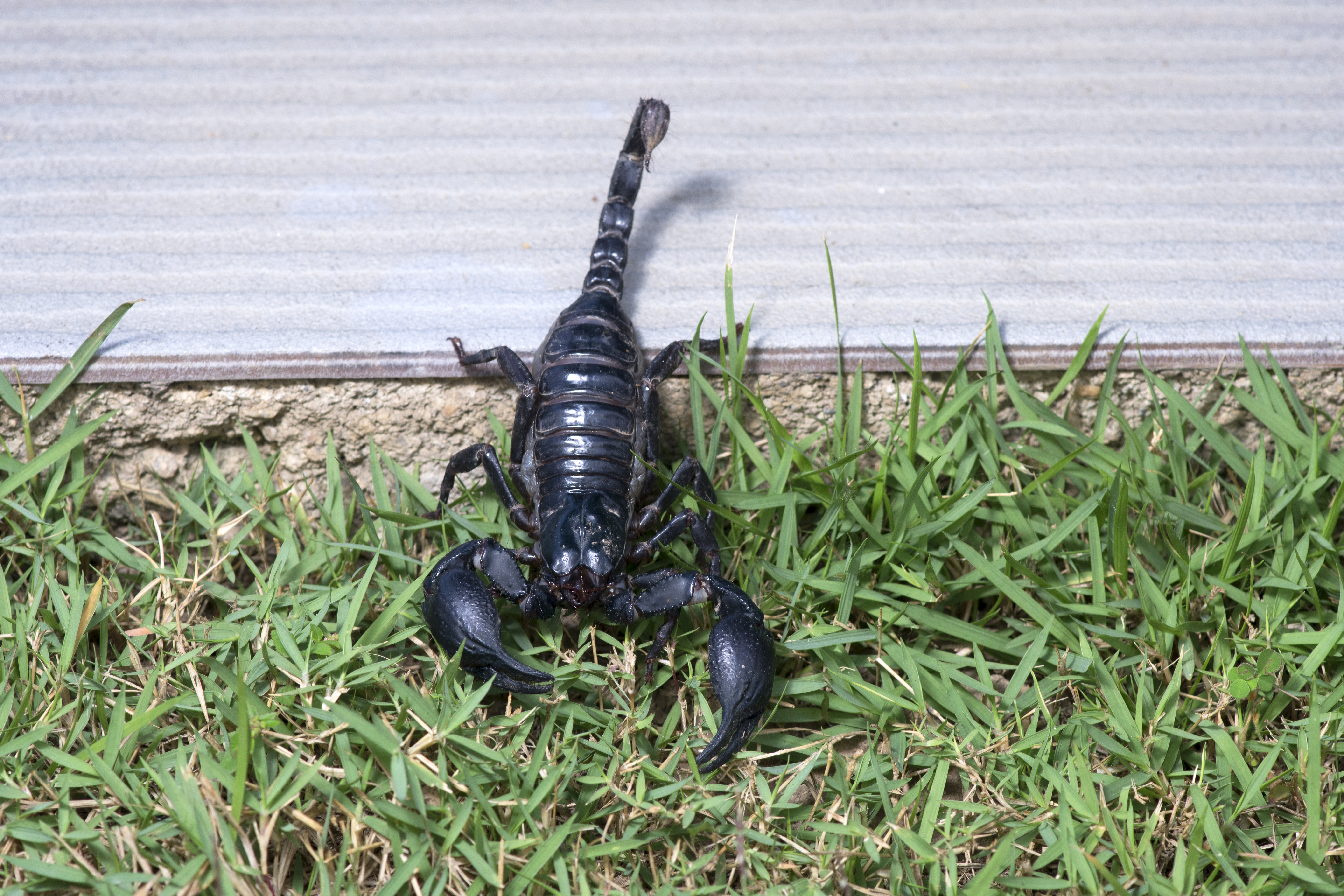
When calculating the cost of hiring a flea exterminator, consider your home size and the infestation extent. This guide will help you figure out what to budget.
The average cost of bee removal is $150 to $500, with a national average of $180. If you need to rebuild a ceiling or wall, plan on spending more.


The cost of bee removal depends on factors such as the type of bee, the size of the infestation, and the location of the hive.
Bees are important natural pollinators, so a safe and minimally destructive removal is vital.
Some professionals offer free honey bee removal to preserve this species of pollinator.
Removing bee nests can be extremely dangerous due to the high sting risk, so the task should be handled by a pest control professional.
The average cost of removing a bee colony ranges from $150 to $500 on average, though this cost will vary depending on the type of hive. If removing the bees from a hard-to-access location, you may have to pay up to $2,000 with the additional carpentry costs.
In some lucky cases, a beekeeper might remove your bees for free. That’s usually not the case, though, so here’s what you can expect to pay for bee removal or relocation and what factors into the cost.
Though removing the hive itself can be a relatively quick and painless process, there are a number of other factors to consider when sourcing a pro to identify, relocate, or exterminate an active bee colony. Here’s a breakdown of how you can expect to spend your money.
| Size of Hive | Cost |
|---|---|
| Small | $75–$180 |
| Medium | $450–$600 |
| Large | $600–$1,000 |
Bees live in colonies that can range from 20,000 to 80,000 critters in one hive. If you have a large hive or multiple hives, this will impact the price as a professional bee removal expert will have more work to do to get rid of them.
Expect to pay around $600 to $1,000 for a large nest removal—more if there are multiple, though each won't cost this much because the initial price likely includes labor, such as cutting into a wall, to gain access. A small, singular hive might only cost $180 or less, depending on location.
Where bees are located in your home can drive up the price you pay for removal.
For example, bees that have festered in a structural wall of your home will likely cost more to remove than a hive attached to a gutter outside, while the cost to remove bees from chimneys tends to be one of the highest. At that point, you also have to figure in repair costs, such as installing new drywall, repairing a deck, or fixing parts of your roof that must be removed to gain access to the bees.
There are no hard and fast rules, but here are some cost guidelines based on location:
| Location | Cost |
|---|---|
| Roof/attic | $200–$1,100 |
| Inside of wall/ceiling | $200–$750 |
| Chimney | $200–$1,500 |
| Tree | $200–$650 |
Bees come in a variety of species—some are no more than friendly garden buddies, while others can be quite dangerous. Consult with a professional beekeeper to identify the type of beehives on your property. The removal costs will differ depending on the type of bees, as each requires special considerations.
| Type of Bee | Cost to Remove | Description |
|---|---|---|
| Honeybee | $75–$2,000 | One of the most common types of bee colonies found in residential areas. Relocation is key as they are important pollinators. |
| Carpenter Bees | $75–$500 | These docile bees can cause structural damage to your home if they are not removed. |
| Bumblebees | $75–$500 | A professional beekeeper may encourage keeping a bumblebee hive, as they rarely sting and live in small colonies. |
| Africanized Honeybees | $100–$1,000 | Known as the “killer bee,” they are extremely dangerous if provoked. Do not try to remove this type of bee colony yourself. |
| Bee Swarm | $125–$200 | A group of bees without a nest or hive, typically led by a queen as they search for a new home. They are relatively docile and easy to control. |

Though removing the hive itself can be a relatively quick and painless process, there are a number of other factors to consider when sourcing a pro to identify, relocate, or exterminate an active bee colony. Here’s a breakdown of how you can expect to spend your money.
Bee removal costs can drastically vary, and other factors affect the price, too. For example, identifying the type of bees and the location of the nest can add to the price of the removal.
You’ll need to hire a professional beekeeper to identify the type of bees on your property. This typically costs $75 per hour, but could increase depending on the hive’s location and the infestation’s severity. Be on the lookout for companies that offer free inspections and quotes.
If the bee colony has made its home behind a wall or in your ceiling, a beekeeper will have to perform some demolition before removal. After the bees are gone, you may have to hire a local carpenter to rebuild the damage.
Here are some of the rebuilding costs you may encounter:
Drywall: If a bee removal expert knocked out some drywall, you will pay $275–$750 to get it replaced.
Ceilings: Bees are occasionally attracted to ceilings. If a specialist had to destroy some portions of your ceiling to get at a hive, expect to pay $300–$1,000 for repairs.
Decks: Some types of bees like to make their home under or inside of a deck. Deck repairs will cost $250–$2,500, depending on size, type, and accrued damage.
Soffit: This is a board that is often located on the underside of a roof eave, helping to bridge the gap between siding and the outer edge of a roof. Unfortunately, the location of the soffit makes it a likely target for beehives. Repairing the soffit will cost $6–$20 per linear foot to repair.
The cost of identifying and removing an active beehive varies depending on where you live, so talk to a local bee remover to get an accurate quote. Typically, removing a live bee colony will be slightly more expensive in heavily populated areas due to regional inflation. Local weather conditions, the number of professional beekeepers in the area, and other factors can also impact the overall cost.
Here are some price estimates for bee removal services in cities throughout the U.S.
| Location | Average Cost to Remove Bees |
|---|---|
| Minneapolis | $160 |
| San Francisco | $240 |
| Denver | $130 |
| Chicago | $160 |
| Los Angeles | $240 |
| Phoenix | $110 |
| Baltimore | $230 |
If possible, the best way to remove bees is to relocate the hive and bees to another habitat. Bees play a crucial role in pollinating plants and supporting ecosystems, so preserving them helps maintain agriculture and biodiversity. It also prevents the release of harmful chemicals used in extermination.
However, in urgent cases, such as if you are highly allergic to bees, you may have to hire an exterminator. Here are the different types of bee removal services, along with their costs.
| Type of Service | Cost | Description |
|---|---|---|
| Relocation | $100–$800 | This involves safely removing and relocating the bees to a more suitable habitat because of their vital role as pollinators. |
| Extermination | $150–$1,000 | If you are highly allergic to bees or it’s an invasive species, then extermination may be necessary. |
| Professional Removal | $75–$1,000 | A bee specialist prioritizes saving the bees and will remove the hive and relocate it. |
Bee removal is the process of safely and humanely relocating bees from an unwanted location to a more suitable one. Bees are crucial pollinators, and harming them can have unintended consequences. When bees are disturbed or killed, they leave honey behind that may seep down and damage your home, leading to unexpected expenses. In a nutshell, protecting bees with proper and professional relocation is a wise ecological and financial move.
Here's a basic overview of the bee removal process.
The first step is to assess the situation. A professional bee remover will identify the type of bee species, the size and location of the hive, and any potential risks involved.
The main goal is to remove the entire hive, including the queen bee and her colony. Depending on the location and accessibility of the hive, different methods may be used, such as vacuuming, smoking, or carefully cutting and extracting the hive.
After removing the hive, the next step is transporting the bees to a safer and more appropriate location, such as a beekeeping facility or another bee-friendly environment.
When damage occurs during removal, such as cutting through walls or ceilings, the bee removal team may also be responsible for making necessary repairs. In some instances, you may need to hire a local carpenter.
To prevent future bee infestations, experts may offer advice on sealing entry points, removing attractants, and taking other measures to deter bees from returning to the exact location.
It’s best for professionals with experience in handling bees to remove them for safety and to disrupt the environment as little as possible. Attempting to remove bees without proper knowledge and equipment can harm bees, people, and the ecosystem.
If the beehive is easy to get to (in other words, it doesn’t involve tearing down any walls), some beekeepers may offer to remove the bees for free or for a donation. It’s more likely that you’ll find free removal for honeybees, as those bees can then work on a honey farm. It’s also more likely to get free bee removal for swarms rather than established hives since they’re relatively easy to capture and relocate to a new hive.
Removal that requires more specialized equipment and expertise will most likely come with a cost, though. Expect to pay somewhere in the $150 to $500 range for established hives, especially if demolition or repairs are necessary.
Hiring a bee removal pro near you costs between $100 and $500 on average, which is nearly 100% of the total cost of the project. Most bee removals that require accessing the interior parts of your home’s walls require professional services, so you can expect higher costs to reflect labor rates from the removal and reparation process.
We recommend working with a bee removal company to safely remove bees, and here’s why:
While you can remove more docile bee species, like carpenter bees, with minimal cost or risk, more dangerous species require professional intervention.
Aggressive bee species can lead to severe injuries—especially if you’re allergic to bee stings.
Some pros can humanely remove bee colonies and relocate them to a more suitable environment.
Pros have the tools and skills to access bees from hard-to-reach areas and repair those areas.
Your pro can address structural issues that lead to bee infestations and offer solutions to prevent future bee hives.
Bee removal pros understand the legal requirements for removing certain types of bee species.
While home insurance and home warranties don’t typically cover pest control, it’s still worth checking the fine print to see if you signed up for special add-on warranties for pest control.
Even though it's best to leave bee removal services to the pros, there are still steps you can take to help out:
Clear any debris blocking access to the bees.
Trim trees or shrubs that make it hard to remove bees.
Study the entry points to help direct your pro to the correct areas of your property.
There are several ways you can save money on bee removal costs.
Contact a local beekeeping association: One of the best ways to cut costs and save the bees is to contact local beekeepers and beekeeping associations. They have the equipment and expertise to properly remove and relocate the bees to a new habitat and sometimes will do it for free or at a lower cost.
Compare pricing: Another way to save money is to compare prices when hiring a bee removal specialist. Get at least three quotes to compare pricing.
Look for free consultations: Some bee removal services offer free consultations so you can gauge the scope of the problem before paying for a treatment.
Decide whether you want humane bee removal services or extermination services. Consult your bee removal pro about your options.
Be prepared to spend extra on structural repairs if the bees are inside your property.
If there is room in your budget, talk with your pro about preventative measures to keep bees off your property.
Consider hiring a carpenter separately for any structural repairs that may be needed after removing the bees for the highest-quality repair service.
Home is the most important place on earth, which is why Angi has helped more than 150 million homeowners transform their houses into homes they adore. To help homeowners with their next project, Angi provides readers with the most accurate cost data and upholds strict editorial standards. We extensively research project costs to develop the pricing data you see, so you can make the best decisions for you and your home. We rely on reputable sources, including the U.S. Bureau of Labor Statistics, academic journals, market studies, and interviews with industry experts—all to ensure our prices reflect real-world projects.
Want to help us improve our cost data? Send us a recent project quote to [email protected]. Quotes and personal information will not be shared publicly.
From average costs to expert advice, get all the answers you need to get your job done.

When calculating the cost of hiring a flea exterminator, consider your home size and the infestation extent. This guide will help you figure out what to budget.

How much does a gnat exterminator cost? The answer depends on the method of treatment and the level of infestation. Find out what plays into your budget.

If you have a serious rodent problem, you may need to know the cost of hiring a rat exterminator. We can help you estimate prices and control costs.

Many popular cockroach treatments are harmful or annoying for pets. We’ve collected the alternatives that get rid of roaches without the same dangers.

Scorpions are creepy pests that you definitely don’t want near your living space. Find out how to keep scorpions away from your house.

Whether it’s a swarm of mosquitos interrupting your summer evening on the patio or the discovery of fleas in the guest room, you may have to break out bug spray. Read on for tips to reduce your exposure and signs of bug spray side effects.